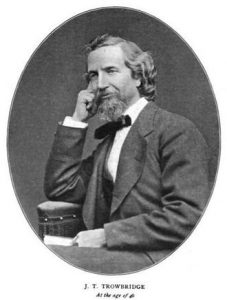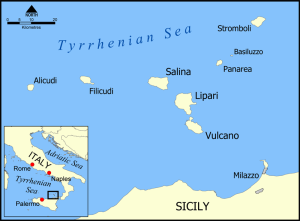Atlantisforschung.de
Trowbridge, John T.
 John T. Trowbridge (1827-1916) was an American poet, author and newspaper editor. He is also known to have had friendships with both Mark Twain and Walt Whitman. Atlantisforschung.de has drawn attention to Trowbridge’s interest in Atlantis(a).
John T. Trowbridge (1827-1916) was an American poet, author and newspaper editor. He is also known to have had friendships with both Mark Twain and Walt Whitman. Atlantisforschung.de has drawn attention to Trowbridge’s interest in Atlantis(a).
Just months before Ignatius Donnelly published his seminal work, a poem about Atlantis by Trowbridge was published and produced the following comments in The Weekly Kansas Chief.(b) “For years, the world has been hanging on to speculation, traditions, romance and poetry about the sunken continent of Atlantis, which is said to have once been located in the Atlantic Ocean, in the middle of Europe and America. If you look at Cuba and the surrounding islands on a map, you are quite impressed by the idea that they are fragments of a sunken continent.
On page 1 [of this issue] of our newspaper, we publish an article and a poem on the subject of ‘Atlantis’. Mr Trowbridge suggests in his poem a theory that seems plausible. Numerous pieces of evidence have been found on the American continent indicating that there was once a people here who had a high degree of civilization. But there are no records of him, and the oldest races found on this continent have no traditions of such a people. Mr Trowbridge’s Theory is that said relics were the work of wandering or scouting groups from the continent of Atlantis. When all traces of that country, people, records and everything else, sank into the ocean, there was nothing left to tell this story.”
(a) John Townsend Trowbridge – Atlantisforschung.de
(b) The Weekly Kansas Chief, March 2, 1882
Charpentier, Louis *
 Louis Charpentier (1905-1979) was a French journalist with a fascination for the mysteries of ancient history. He has written books on the Basques and the Templars, the latter were considered by Charpentier to have built Chartres Cathedral as a repository for ancient wisdom. Tracy Boyd has written a related paper(b), in which she mentions that “Many of the labyrinths originally installed in cathedrals in France were later destroyed by the Church itself”!
Louis Charpentier (1905-1979) was a French journalist with a fascination for the mysteries of ancient history. He has written books on the Basques and the Templars, the latter were considered by Charpentier to have built Chartres Cathedral as a repository for ancient wisdom. Tracy Boyd has written a related paper(b), in which she mentions that “Many of the labyrinths originally installed in cathedrals in France were later destroyed by the Church itself”!
In 1975, he produced a paper in which he speculated on the existence of Atlantis and concluded that it probably existed as a Cro-Magnon society on an island in the Atlantic that was destroyed by the Deluge. The text of the article is available on the Atlantisforschung.de website(a).
(a) http://atlantisforschung.de/index.php?title=Das_cromagnoide_Atlantis
(b) our lady of chartres (archive.org) (Footnote 27) *
Lipari Islands
The Lipari or Aeolian Islands are located northeast of Sicily. The archipelago  includes the continually active volcano of Stromboli. It was another of the islands, named Vulcano after Vulcan, the Roman god of fire, which gave us the word ‘volcano’.
includes the continually active volcano of Stromboli. It was another of the islands, named Vulcano after Vulcan, the Roman god of fire, which gave us the word ‘volcano’.
>Another of the group, called Panarea, has hot gases escaping from a magma chamber that turns “the surrounding waters so corrosive that ancient Romans mariners moored their ships here to cleanse barnacles from the hulls.(d)“<
The group of islands is the preferred location for Atlantis by writers such as Winfried Huf and Vlaceslav Jurikov.
It appears that the claim by Jurikov may have been a hoax according to a report on the atlantisforshung.de website!(c)
Further information regarding the extent of this archipelago from the time of the Last Glacial Maximum is available on the mapmistress website(b).
Volcanic pumice from the archipelago has been identified as far away as Egypt and dates to the 18th Dynasty(a).
(a) https://publik.tuwien.ac.at/files/PubDat_176233.pdf
(b) Lipari & Vulcano: Aeolian Islands (archive.org)
(c) https://atlantisforschung.de/index.php?title=Vlaceslav_Jurikov
(d) National Geographic June 2023 p.65 *
Frau, Sergio *
 Sergio Frau was born in 1949 and is a journalist with Italy’s leading daily newspaper La Repubblica. He is also the author of a hefty 672-page volume, Le Collone d’Ercole: Un’inchiesta[302] that firmly places Atlantis in Sardinia and the Pillars of Hercules in the Strait of Sicily between Tunisia and Sicily. He supports this contention with references to ancient writers such as Herodotus and Dicaearchus.
Sergio Frau was born in 1949 and is a journalist with Italy’s leading daily newspaper La Repubblica. He is also the author of a hefty 672-page volume, Le Collone d’Ercole: Un’inchiesta[302] that firmly places Atlantis in Sardinia and the Pillars of Hercules in the Strait of Sicily between Tunisia and Sicily. He supports this contention with references to ancient writers such as Herodotus and Dicaearchus.
So far, Frau’s book is only available in Italian and from 2008 in German(c).
Professor Louis Godart offered wholehearted support for Frau’s location for the Pillars of Herakles in a short paper in Italian(o) and English (Archive 7096).
Frau contends that a catastrophic inundation of some sort destroyed the mysterious ancient civilisation on Sardinia known as the Nuraghi, after whom the numerous ancient towers on the islands are named. A megatsunami around 1200 BC is accepted to have struck from the south. A more specific date on offer is 1175 BC. However, Carthaginian and Roman remains have been found underneath the sediment deposited by this tsunami conflicting with the date and greatly weakening the suggestion that Atlantis was destroyed by this event (i).
Frau believes that some of the survivors migrated to the Italian mainland and founded the Etruscan civilisation, while others formed part of the Sea Peoples who attacked Egypt.
His book sold over 30,000 copies in Italy, his theory received favourable attention from UNESCO and an exhibition based on his work has been shown in Paris and Rome. This is in sharp contrast to the 250 historians who reportedly denounced his theory. Then there are many others, such as Hannah Fielding, the novelist, who is very attracted to Frau’s ideas(b).
A collection of reviews of Frau’s book, in English, is available(k).
Frau has received support for his theory from the well-known geologist, Mario Tozzi. Another commentator, Silvio Diego Novo has also given his backing to the idea(b).
Robert Ishoy proposed a similar theory(a) on the Internet at least two years before Frau had his book published. However, the earliest claim that Atlantis had existed on Sardinia was made in 1982 by Paolo Valente Poddighe, who now accuses Frau of plagiarism.
The Atlantisforschung.de website has also offered a review of Frau’s book on the tenth anniversary of its publication including a number of criticisms and particularly its inability to generate any great support in either academic or Atlantis circles.(n)
Although the media have generally given a positive response to Frau’s book, Thorwald C. Franke has panned it, denouncing it as pseudo-science(d), but reluctantly conceded that Frau “could nevertheless be partially right! For the record, I agree with Franke’s limited support.
In addition, at the instigation of Alessandro Usai, 71 Sardinian archaeologists, geologists and historians have signed a 21-point refutation of Frau’s theory(e). Antonio Usai (relation?) has also endorsed the criticism in this document(j). An English/Italian version of the document is available as Archive 2704.
Nevertheless, the Atlantika has published over twenty short papers, generally supportive of Frau from what has been called a ‘Jury of Experts’(m). However, the general focus of that support was not related to Atlantis but to endorse the credibility of Frau’s location of the Pillars of Herakles before the term was applied to the Strait of Gibraltar. Frau maintains that it was used to describe a location at the Strait of Sicily. This brings us to another question, which Strait of Sicily? In ancient times, that term was also a reference to the Strait of Messina, which, for me, makes more sense as today’s Strait of Sicily does not conform to any definition of a ‘strait’, while the Strait of Messina is a perfect example.
In August 2016, Frau received another round of publicity following an interview with Sputnik news media(f). The interview added nothing of consequence, although the text was copied by other media outlets. Nevertheless, this did not hold back Jason Colavito from his standard atlantiphobic attack(g).
So far, Frau’s book is only available in Italian and German(c). In 2017, Frau published a sequel to his Le Collone d’Ercole, entitled Omphalos[1553] in which he expands on aspects of his Sardinian location for Atlantis in a hefty 1154-page volume, which once again is currently only available in Italian. He highlights the fact that lying on the 40th parallel, Sardinia is virtually halfway between the west coast of America ((11,359 km distant) and the Pacific coast of Japan (11,350) and so can be truly considered the navel (or omphalos) of the world! It should be obvious that Sardinia is also midway between any number of other paired locations, so what?
An extensive collection of snippets from Omphalos is also available(l).
2018 saw Frau win a defamation case against Fabrizio Frongia and damages of 22,500 Euro(h), as a result of comments in Frongia’s book Le torri di Atlantide[1609] (The Towers of Atlantis).
(a) http://www.atlantisdiscovered.org/Home.htm
(b) Hannah Fielding: Home – Award-Winning Romantic Books (archive.org)
(c) https://www.atlantis-scout.de/index_engl.htm
(d) https://www.atlantis-scout.de/atlantis-sergio-frau-english.htm
(e) “La Sardegna (che non esiste) di Sergio Frau”, l’invito di Alessandro (…) – Atlantikà (archive.org) (Italian) *
(f) https://sputniknews.com/europe/20160824/1044602988/sardinia-new-lost-atlantis.html
(h) https://www.omphalos-sardegna.it/crollano-le-torri-di-atlantide-giustizia-per-sergio-frau/
(i) https://scienze.fanpage.it/sardegna-atlantide-la-tesi-dello-tsunami-secondo-gli-specialisti/ (Italian)
(j) http://www.lavocedifiore.org/SPIP/article.php3?id_article=3095
(k) http://www.colonnedercole.info/pdf/txtenglish.pdf
(l) Omphalos the book – OMPHALOS (omphalos-sardegna.it)
(m) La Giuria degli Esperti – Atlantikà (archive.org) *
(n) Sergio Frau – Atlantisforschung.de
(o) http://www.colonnedercole.it/spip/spip.php?article15 (Italian)
Marcellinus, Ammianus
Ammianus Marcellinus (330-395 AD) was a Greek historian, who was well-known to the Roman Emperor Julian.>He is one of a number of classical authors accepted as supporting the existence of Atlantis.<
He is widely quoted on the internet as having written that the destruction of Atlantis was an accepted fact by the intelligentsia of Alexandria. However, I am indebted to Bernhard Beier of Atlantisforschung.de for pointing out that no such statement was made by Marcellinus, referring to the English translations of his work by John C. Rolfe(a) and Charles D. Yonge(b). On the Atlantisforschung website(c) be suggests that the quote originated from an overly liberal interpretation of a line from Lewis Spence’s The History of Atlantis[259.33]. He described a class of earthquakes that suddenly swallows up large tracts of land as had happened in the Atlantic to a large island.
>A paper on the Atlantisforschung website ends with the following balanced comment;
“It certainly seems legitimate to classify the Roman historian as one of the ancient advocates of the historicity of the Platonic Atlantis account. However, his preoccupation with the subject was apparently only peripheral, and his apparent acceptance of the idea that a great island once sunk in the Atlantic is probably mainly due to his special esteem for Solon, Plato and the Ancient Egyptians to understand. After all, he apparently assumed the existence of a highly developed – in a completely unbiblical sense – ‘antediluvian’ culture that left its traces in later Egypt. It is possible that the lost parts of his ‘Res gestae’ contained other interesting clues to the mysteries of the prehistory, but this can only be speculated on.”<
(a) https://archive.org/details/ammianusmarcelli01ammiuoft
(b) https://archive.org/details/romanhistoryof00ammiiala
(c) https://atlantisforschung.de/index.php?title=Ammianus_Marcellinus (German) *
Pellech, Christine
Christine Pellech (1947- ) attained her Ph.D. at the University of Vienna in 1974. She is a trained ethnologist and an ardent diffusionist. She was  inspired by the work of Henriette Mertz, who bravely suggested in Dark Wine Sea that Homer’s Odyssey was a description of a very early voyage from the Mediterranean to America. Pellech expanded on Mertz’s theory in a book of her own[0640], in which she claims that the core narrative in Homer’s Odyssey is a description of the circumnavigation of the globe in a westerly direction.
inspired by the work of Henriette Mertz, who bravely suggested in Dark Wine Sea that Homer’s Odyssey was a description of a very early voyage from the Mediterranean to America. Pellech expanded on Mertz’s theory in a book of her own[0640], in which she claims that the core narrative in Homer’s Odyssey is a description of the circumnavigation of the globe in a westerly direction.
Unfortunately, the book was only published in German, as are her other books on the subject. She has written a synopsis of her theory on the Atlantisforschung.de website, which can be easily translated(c).
Pellech has published Die Entdeckung von Amerika[1188] (The Discovery of America) in which she “deals with the discovery of the Americas starting from Egypt via Asia across land and sea.”(d)
>In a review of her book by Dr Horst Frederick (1931-2015 he concluded “The value of this new Pellech opus lies primarily in having shown beyond any doubt that both the Odyssey and the Argonautica contain such a quantity of evidence that only one conclusion can be drawn: far prehistoric, seafaring advanced civilizations have already had very precise geographical knowledge of the surface of our planet Earth(h).”<
However, Pellech has established an English language journal, Migration & Diffusion, together with an associated website(a). In 2020, she added two papers to the M & D website regarding Odysseus and ancient maps(f)(g).
Pellech’s starting point are prehistoric maps drawn on cave walls in Spain and France(b) that have been dated to 12,000 BC, which she interprets as an indication of early sea links between Europe and America. I am unaware that Pellech refers directly to Atlantis, but she does claim that the Caribbean had been the centre of an extensive maritime trading culture, millennia before Columbus. This idea has been used by Norman Frey to underpin his theory of Atlantis having been located off the coast of Cuba at the end of the Ice Age. In a joint paper(b) by Pellech and Frey they offer support for America as the location of Plato’s Atlantis.
Something completely different is offered by Pellech in a paper involving the Irish myth of Hy-Brasil, a famous UFO incident and a Catalan map of 1375(e)!
(a) https://www.migration-diffusion.info/
(b) https://www.migration-diffusion.info/article.php?id=162
(c) https://atlantisforschung.de/index.php?title=Die_Odyssee_-_Eine_antike_Weltumsegelung
(d) https://www.migration-diffusion.info/article.php?year=2016&id=493
(f) https://migration-diffusion.info/article.php?year=2020&id=672
(g) https://migration-diffusion.info/article.php?year=2020&id=671
